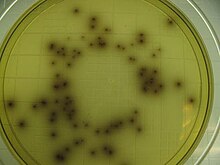| Listeria | |
|---|---|

| |
| micrograph of Listeria monocytogenes bacterium in tissue | |
| Scientific classification | |
| Domain: | Bacteria |
| Phylum: | Bacillota |
| Class: | Bacilli |
| Order: | Caryophanales |
| Family: | Listeriaceae |
| Genus: | Listeria Pirie 1940 |
| Species | |
|
L. aquatica | |


Listeria is a genus of bacteria that acts as an intracellular parasite in mammals. As of 2024, 28 species have been identified.[1][2][3] The genus is named in honour of the British pioneer of sterile surgery Joseph Lister. Listeria species are Gram-positive, rod-shaped, and facultatively anaerobic, and do not produce endospores.[4]
The major human pathogen in the genus is L. monocytogenes. Although L. monocytogenes has low infectivity, it is hardy and can grow in a refrigerator temperature of 4 °C (39.2 °F) up to the human body temperature of 37 °C (98.6 °F).[5] It is the usual cause of the relatively rare bacterial disease listeriosis, an infection caused by eating food contaminated with the bacteria. The overt form of the disease has a case-fatality rate of around 20–30%. Listeriosis can cause serious illness in pregnant women, newborns, adults with weakened immune systems and the elderly, and may cause gastroenteritis in others who have been severely infected. The incubation period can vary from three to 70 days.[6] The two main clinical manifestations are sepsis and meningitis, often complicated by encephalitis, a pathology unusual for bacterial infections.
L. ivanovii is a pathogen of mammals, specifically ruminants, and rarely causes listeriosis in humans.[7]
- ^ Jones, D. 1992. Current classification of the genus Listeria. In: Listeria 1992. Abstracts of ISOPOL XI, Copenhagen, Denmark). p. 7-8. ocourt, J., P. Boerlin, F.Grimont, C. Jacquet, and J-C. Piffaretti. 1992. Assignment of Listeria grayi and Listeria murrayi to a single species, Listeria grayi, with a revised description of Listeria grayi. Int. J. Syst. Bacteriol. 42:171-174.
- ^ Boerlin et al. 1992. L. ivanovii subsp. londoniensis subsp. novi. Int. J. Syst. Bacteriol. 42:69-73. Jones, D., and H.P.R. Seeliger. 1986. International committee on systematic bacteriology. Subcommittee the taxonomy of Listeria. Int. J. Syst. Bacteriol. 36:117-118.
- ^ Orsi, Renato H.; Liao, Jingqiu; Carlin, Catharine R.; Wiedmann, Martin (14 February 2024). Prasad, Vinayaka R. (ed.). "Taxonomy, ecology, and relevance to food safety of the genus Listeria with a particular consideration of new Listeria species described between 2010 and 2022". mBio. 15 (2): e0093823. doi:10.1128/mbio.00938-23. ISSN 2150-7511. PMC 10865800. PMID 38126771.
- ^ Singleton P (1999). Bacteria in Biology, Biotechnology and Medicine (5th ed.). Wiley. pp. 444–454. ISBN 0-471-98880-4.
- ^ Southwick, F. S.; D. L. Purich. "More About Listeria". University of Florida Medical School. Archived from the original on 22 February 2001. Retrieved 7 March 2007. [No longer accessible. Archived version available here.]
- ^ "Listeria". FoodSafety.gov. 12 April 2019.
- ^ Christelle Guillet, Olivier Join-Lambert, Alban Le Monnier, Alexandre Leclercq, Frédéric Mechaï, Marie-France Mamzer-Bruneel, Magdalena K. Bielecka, Mariela Scortti, Olivier Disson, Patrick Berche, José Vazquez-Boland, Olivier Lortholary, and Marc Lecuit. "Human Listeriosis Caused by Listeria ivanovii". Emerg Infect Dis. 2010 January; 16(1): 136–138.